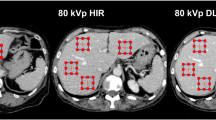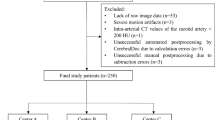Opinion statement
Endovascular procedures expose both patients and physicians to fluoroscopic ionizing radiation that carries a dose-dependent risk of acute toxicity and a small, but demonstrable, long-term risk of malignancy due to resultant genetic mutations. Exposure doses vary widely based upon patient-related factors including body size and anatomic complexity, operator technique, procedure type (diagnostic vs. therapeutic), vascular bed imaged, and imaging equipment employed. Effective dosage may vary as much as 200-fold for physicians and 20-fold for patients depending upon the procedure: for example, complex aortic interventions with branched graft devices may convey mean effective doses of more than 0.4 mSv for physicians and 100 mSv for patients, whereas distal, small-vessel angiography may entail mean effective doses of less than 0.002 mSv for physicians and 5 mSv for patients. Particular attention is given to physicians’ ocular exposure, which may cause cataract development, and to hand exposure, which is significantly higher than total body exposure when operators work near the x-ray beam. Given the risks of radiation exposure, numerous strategies have been developed to reduce both physician and patient doses. These measures include physician education about dose-reducing imaging techniques, development of low-dose imaging equipment, introduction of new radiation shielding drapes and caps, and real-time dose monitoring. Here, we review physician and patient effective doses of radiation by procedure type as reported in the literature and present recent data regarding dose-reduction strategies.
Similar content being viewed by others
References and Recommended Reading
Papers of particular interest, published recently, have been highlighted as: • Of importance •• Of major importance
Lomax ME, Folkes LK, O’Neill P. Biological consequences of radiation-induced DNA damage: relevance to radiotherapy. Clin Oncol (R Coll Radiol). 2013;25(10):578–85. doi:10.1016/j.clon.2013.06.007.
Avoidance of radiation injuries from medical interventional procedures. Ann ICRP. 2000; ICRP Publication No. 85(30):7-67.
Kirkwood ML, Arbique GM, Guild JB, Timaran C, Valentine RJ, Anderson JA. Radiation-induced skin injury after complex endovascular procedures. J Vasc Surg. 2014;60(3):742–8. doi:10.1016/j.jvs.2014.03.236.
•• Roguin A, Goldstein J, Bar O, Goldstein JA. Brain and neck tumors among physicians performing interventional procedures. Am J Cardiol. 2013;111(9):1368–72. doi:10.1016/j.amjcard.2012.12.060. Roguin’s landmark case series suggests an irrefutable connection between physicians’ occupation radiation exposure and subsequent brain malignancy.
Haqqani OP, Agarwal PK, Halin NM, Iafrati MD. Defining the radiation “scatter cloud” in the interventional suite. J Vasc Surg. 2013;58(5):1339–45. doi:10.1016/j.jvs.2013.01.025.
Limacher MC, Douglas PS, Germano G, Laskey WK, Lindsay BD, McKetty MH, et al. ACC expert consensus document. Radiation safety in the practice of cardiology. American College of Cardiology. J Am Coll Cardiol. 1998;31(4):892–913.
Hong MS, Beck AW, Nelson PR. Emerging national trends in the management and outcomes of lower extremity peripheral arterial disease. Ann Vasc Surg. 2011;25(1):44–54. doi:10.1016/j.avsg.2010.08.006.
Bolus NE. NCRP report 160 and what it means for medical imaging and nuclear medicine. J Nucl Med Technol. 2013;41(4):255–60. doi:10.2967/jnmt.113.128728.
Bedetti G, Botto N, Andreassi MG, Traino C, Vano E, Picano E. Cumulative patient effective dose in cardiology. Br J Radiol. 2008;81(969):699–705. doi:10.1259/bjr/29507259.
Smith-Bindman R, Lipson J, Marcus R, Kim KP, Mahesh M, Gould R, et al. Radiation dose associated with common computed tomography examinations and the associated lifetime attributable risk of cancer. Arch Intern Med. 2009;169(22):2078–86. doi:10.1001/archinternmed.2009.427.
Patel AP, Gallacher D, Dourado R, Lyons O, Smith A, Zayed H, et al. Occupational radiation exposure during endovascular aortic procedures. Eur J Vasc Endovasc Surg. 2013;46(4):424–30. doi:10.1016/j.ejvs.2013.05.023.
Panuccio G, Greenberg RK, Wunderle K, Mastracci TM, Eagleton MG, Davros W. Comparison of indirect radiation dose estimates with directly measured radiation dose for patients and operators during complex endovascular procedures. J Vasc Surg. 2011;53(4):885–94.e1. doi:10.1016/j.jvs.2010.10.106.
Attigah N, Oikonomou K, Hinz U, Knoch T, Demirel S, Verhoeven E, et al. Radiation exposure to eye lens and operator hands during endovascular procedures in hybrid operating rooms. J Vasc Surg. 2016;63(1):198–203. doi:10.1016/j.jvs.2015.08.051.
Albayati MA, Kelly S, Gallagher D, Dourado R, Patel AS, Saha P, et al. Editor’s choice—angulation of the C-arm during complex endovascular aortic procedures increases radiation exposure to the head. Eur J Vasc Endovasc Surg. 2015;49(4):396–402. doi:10.1016/j.ejvs.2014.12.032.
Almén A, Sandblom V, Båth M, Lundh C. Optimisation of occupational radiological protection in image-guided interventions: potential impact of dose rate measurements. J Radiol Prot. 2015;35(1):47–62. doi:10.1088/0952-4746/35/1/47.
•• Ingwersen M, Drabik A, Kulka U, Oestreicher U, Fricke S, Krankenberg H, et al. Physicians’ radiation exposure in the catheterization lab: does the type of procedure matter? JACC Cardiovasc Interv. 2013;6(10):1095–102. doi:10.1016/j.jcin.2013.05.012. Ingwersen provides the most comprehensive catalog of physician radiation exposure during endovascular procedures.
Heye S, Maleux G, Oyen RH, Claes K, Kuypers DR. Occupational radiation dose: percutaneous interventional procedures on hemodialysis arteriovenous fistulas and grafts. Radiology. 2012;264(1):278–84. doi:10.1148/radiol.12110978.
Ullery BW, Landau B, Wang GJ, Faifrman RM, Woo EY. Radiation dose to the interventionalist is directly affected by the operating position. Vascular. 2014;22(2):149–53. doi:10.1177/1708538113476452.
Kirkwood ML, Guild JB, Arbique GM, Anderson JA, Valentine RJ, Timaran C. Surgeon radiation dose during complex endovascular procedures. J Vasc Surg. 2015;62(2):457–63. doi:10.1016/j.jvs.2015.02.050.
Mohapatra A, Greenberg RK, Mastracci TM, Eagleton MJ, Thornsberry B. Radiation exposure to operating room personnel and patients during endovascular procedures. J Vasc Surg. 2013;58(3):702–9. doi:10.1016/j.jvs.2013.02.032.
Sailer AM, Schurink GW, Bol ME, de Haan MW, van Zwam WH, Wildberger JE, et al. Occupational radiation exposure during endovascular aortic repair. Cardiovasc Intervent Radiol. 2015;38(4):827–32. doi:10.1007/s00270-014-1025-8.
Kendrick DE, Miller CP, Moorehead PA, Kim AH, Baele HR, Wong VL, et al. Comparative occupational radiation exposure between fixed and mobile imaging systems. J Vasc Surg. 2016;63(1):190–7. doi:10.1016/j.jvs.2015.08.062.
Fossaceca R, Brambilla M, Guzzardi G, Cerini P, Renghi A, Valzano S, et al. The impact of radiological equipment on patient radiation exposure during endovascular aortic aneurysm repair. Eur Radiol. 2012;22(11):2424–31. doi:10.1007/s00330-012-2492-4.
Vidovich MI, Khan AA, Xie H, Shroff AR. Radiation safety and vascular access: attitudes among cardiologists worldwide. Cardiovasc Revasc Med. 2015;16(2):109–15. doi:10.1016/j.carrev.2015.01.005.
Code of Federal Regulations 10, 20.1201 Subpart C (1991).
Howells P, Eaton R, Patel AS, Taylor P, Modarai B. Risk of radiation exposure during endovascular aortic repair. Eur J Vasc Endovasc Surg. 2012;43(4):393–7. doi:10.1016/j.ejvs.2011.12.031.
Bannazadeh M, Altinel O, Kashyap VS, Sun Z, Clair D, Sarac TP. Patterns of procedure-specific radiation exposure in the endovascular era: impetus for further innovation. J Vasc Surg. 2009;49(6):1520–4. doi:10.1016/j.jvs.2009.02.015.
Majewska N, Stanisić MG, Kłos MA, Makałowski M, Frankiewicz M, Juszkat R, et al. Patients’ radiation doses during thoracic stent-graft implantation: the problem of long-lasting procedures. Ann Thorac Surg. 2012;93(2):465–72. doi:10.1016/j.athoracsur.2011.09.062.
Kalef-Ezra JA, Karavasilis S, Ziogas D, Dristiliaris D, Michalis LK, Matsagas M. Radiation burden of patients undergoing endovascular abdominal aortic aneurysm repair. J Vasc Surg. 2009;49(2):283–7. doi:10.1016/j.jvs.2008.09.003. discussion 7.
Ho P, Cheng SW, Wu PM, Ting AC, Poon JT, Cheng CK, et al. Ionizing radiation absorption of vascular surgeons during endovascular procedures. J Vasc Surg. 2007;46(3):455–9. doi:10.1016/j.jvs.2007.04.034.
Monastiriotis S, Comito M, Labropoulos N. Radiation exposure in endovascular repair of abdominal and thoracic aortic aneurysms. J Vasc Surg. 2015;62(3):753–61. doi:10.1016/j.jvs.2015.05.033.
Jones C, Badger SA, Boyd CS, Soong CV. The impact of radiation dose exposure during endovascular aneurysm repair on patient safety. J Vasc Surg. 2010;52(2):298–302. doi:10.1016/j.jvs.2010.03.004.
Maurel B, Sobocinski J, Perini P, Guillou M, Midulla M, Azzaoui R, et al. Evaluation of radiation during EVAR performed on a mobile C-arm. Eur J Vasc Endovasc Surg. 2012;43(1):16–21. doi:10.1016/j.ejvs.2011.09.017.
Segal E, Weinberg I, Leichter I, Klimov A, Giri J, Bloom AI. Patient radiation exposure during percutaneous endovascular revascularization of the lower extremity. J Vasc Surg. 2013;58(6):1556–62. doi:10.1016/j.jvs.2013.06.016.
Thornton RH, Dauer LT, Altamirano JP, Alvarado KJ, St Germain J, Solomon SB. Comparing strategies for operator eye protection in the interventional radiology suite. J Vasc Interv Radiol. 2010;21(11):1703–7. doi:10.1016/j.jvir.2010.07.019.
Sigterman TA, Bolt LJ, Snoeijs MG, Krasznai AG, Heijboer R, Schurink GW, et al. Radiation exposure during percutaneous transluminal angioplasty for symptomatic peripheral arterial disease. Ann Vasc Surg. 2016;33:167–72. doi:10.1016/j.avsg.2015.11.019.
Chambers CE, Fetterly KA, Holzer R, Lin PJ, Blankenship JC, Balter S, et al. Radiation safety program for the cardiac catheterization laboratory. Catheter Cardiovasc Interv. 2011;77(4):546–56. doi:10.1002/ccd.22867.
• Power S, Mirza M, Thakorlal A, Ganai B, Gavagan LD, Given MF, et al. Efficacy of a radiation absorbing shield in reducing dose to the interventionalist during peripheral endovascular procedures: a single centre pilot study. Cardiovasc Intervent Radiol. 2015;38(3):573–8. doi:10.1007/s00270-014-0997-8. Power demonstrates the efficacy of the RADPAD device in reducing physician radiation exposure.
• Uthoff H, Quesada R, Roberts JS, Baumann F, Schernthaner M, Zaremski L, et al. Radioprotective lightweight caps in the interventional cardiology setting: a randomised controlled trial (PROTECT). EuroIntervention. 2015;11(1):53–9. doi:10.4244/EIJV11I1A9. Uthoff’s trial demonstrates the efficacy of a barium sulfate-bismuth oxide cap in reducing physician’s head exposure to radiation.
Reeves RR, Ang L, Bahadorani J, Naghi J, Dominguez A, Palakodeti V, et al. Invasive cardiologists are exposed to greater left sided cranial radiation: the BRAIN study (brain radiation exposure and attenuation during invasive cardiology procedures). JACC Cardiovasc Interv. 2015;8(9):1197–206. doi:10.1016/j.jcin.2015.03.027.
van den Haak RF, Hamans BC, Zuurmond K, Verhoeven BA, Koning OH. Significant radiation dose reduction in the hybrid operating room using a novel X-ray imaging technology. Eur J Vasc Endovasc Surg. 2015;50(4):480–6. doi:10.1016/j.ejvs.2015.06.025.
• Racadio J, Nachabe R, Carelsen B, Hilvert N, Johnson N, Kukreja K, et al. Effect of real-time radiation dose feedback on pediatric interventional radiology staff radiation exposure. J Vasc Interv Radiol. 2014;25(1):119–26. doi:10.1016/j.jvir.2013.08.015. Racadio reports the efficacy of real-time physician dose feedback on reducing radiation use.
• Savage C, Seale IV TM, Shaw CJ, Bruner AP, Marichal D, Rees CR. Evaluation of a suspended personal radiation protection system vs. conventional apron and shields in clinical interventional procedures. Open J Radiol. 2013;3:143–51. Savage reports the efficacy of the Zero-Gravity system, heavy shielding mounted from above, on reducing physician radiation exposure.
•• Mahmud E, Schmid F, Kalmar P, Deutschmann H, Hafner F, Rief P, et al. Feasibility and safety of robotic peripheral vascular interventions: results of the RAPID trial. JACC Cardiovasc Interv. 2016;9(19):2058–64. doi:10.1016/j.jcin.2016.07.002. Mahmud debuts the CorPath 200 robotic angioplasty system, which virtually eliminates physician radiation exposure.
Stansfield T, Parker R, Masson N, Lewis D. The endovascular preprocedural run through and brief: a simple intervention to reduce radiation dose and contrast load in endovascular aneurysm repair. Vasc Endovasc Surg. 2016;50(4):241–6. doi:10.1177/1538574416644527.
Kirkwood ML, Arbique GM, Guild JB, Timaran C, Chung J, Anderson JA, et al. Surgeon education decreases radiation dose in complex endovascular procedures and improves patient safety. J Vasc Surg. 2013;58(3):715–21. doi:10.1016/j.jvs.2013.04.004.
•• Agarwal S, Parashar A, Ellis SG, Heupler FA, Lau E, Tuzcu EM, et al. Measures to reduce radiation in a modern cardiac catheterization laboratory. Circ Cardiovasc Interv. 2014;7(4):447–55. doi:10.1161/CIRCINTERVENTIONS.114.001499. Agarwal reports on reducing patient radiation exposure by adoption of a series of dose-reduction imaging techniques.
Peach G, Sinha S, Black SA, Morgan RA, Loftus IM, Thompson MM, et al. Operator-controlled imaging significantly reduces radiation exposure during EVAR. Eur J Vasc Endovasc Surg. 2012;44(4):395–8. doi:10.1016/j.ejvs.2012.08.001.
Pitton MB, Kloeckner R, Schneider J, Ruckes C, Bersch A, Düber C. Radiation exposure in vascular angiographic procedures. J Vasc Interv Radiol. 2012;23(11):1487–95. doi:10.1016/j.jvir.2012.05.048.
Kirkwood ML, Guild JB, Arbique GM, Tsai S, Modrall JG, Anderson JA, et al. New image-processing and noise-reduction software reduces radiation dose during complex endovascular procedures. J Vasc Surg. 2016. doi:10.1016/j.jvs.2016.04.062.
Ephrem G, Lau JF, Meraj PM. The fluoro-less and contrast-less peripheral endovascular intervention: a concept for the future today. Cardiovasc Revasc Med. 2015;16(5):294–8. doi:10.1016/j.carrev.2015.05.004.
Author information
Authors and Affiliations
Corresponding author
Ethics declarations
Conflict of Interest
The authors declare that they have no conflicts of interest.
Human and Animal Rights and Informed Consent
This article does not contain any studies with human or animal subjects performed by any of the authors.
Additional information
This article is part of the Topical Collection on Vascular Disease
Rights and permissions
About this article
Cite this article
Goldsweig, A.M., Abbott, J.D. & Aronow, H.D. Physician and Patient Radiation Exposure During Endovascular Procedures. Curr Treat Options Cardio Med 19, 10 (2017). https://doi.org/10.1007/s11936-017-0507-9
Published:
DOI: https://doi.org/10.1007/s11936-017-0507-9




